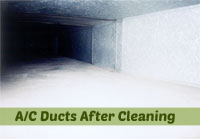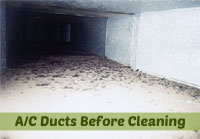Air ducts and Ventilation systems naturally accumulate sizeable deposits of fine dust particles and other contaminants over a period of time. These deposits combined with the temperature and moist atmosphere within the ventilation system often yield mould growth and bacterial colonies.
Deposits of debris can also reduce efficiency of the air conditioning system, create a fire hazard and even cause physical discomfort by degrading the quality of the air one breaths indoors.
It can result in a variety of allergy related problems including skin rash, frequent coughs and colds, asthma and various other allergy and bacterial allergy related diseases.
To eliminate the high-risk area of infection and allergens, the entire AC system including the ducts, coils and AHU’s should be cleaned and sanitised by a professional ‘Air Systems Hygiene’ company, certified by NADCA (National Air Duct Cleaners Association).



EPSCO cleans, Air conditioning systems so as to meet the latest NADCA standards. NADCA is a non-profit organisation, which sets cleaning standards in the USA for Air System Hygiene Specification.
The standard provides qualitative and quantitative methods to measure duct debris, allowing consumers to conclusively determine the success of a HVAC cleaning project. These standards are globally accepted in several countries as the benchmark for the industry.
EPSCO’s key staff, including those in India have earned the "Air System Cleaning Specialists" certification awarded to individuals who pass a tough professional knowledge test conducted by NADCA.
Most of person's exposure to many air pollutants comes through inhalation of indoor air, both because of the amount of time spent indoors and because of the higher pollution levels indoors. According to the World Health Organization, about one-third of new buildings worldwide are not fit for human use due to severe indoor air pollution. Important sources of chemical indoor pollutants include, the human body and human activities, emissions from building materials, furnishing and appliances and use of consumer products.
Samples are taken from the area being tested by use of swabs, dip slides or Petri Dishes and are analysed in the laboratory by trained staff.
Many people believe in different methods to improve the quality of Indoor Air. Some promote ‘Ozonisers’ some promote ‘Ionisers’. Each of these systems has advantages as well as disadvantages. We (EPSCO) firmly believe in removal of particulates whether they are dust particles, smoke or odours. This can be achieved by using HEPA (High Efficiency Particle Air) Filters that are incorporated in a portable fan housing. This type of unit removes 99.97% of particles to a size of 0.3 microns. This includes cigarette smoke, pollen and most mould spores. Another method is to use electronic polarising filters that replace the filters in the A/C unit. These units are extremely efficient and work without reducing airflow from the A/C unit.
Odour can be controlled or eliminated by a variety of chemical neutralisers or the use of zone generating equipment. Activated carbon filters also play a part.
Mould spores are everywhere and given the right conditions will grow and multiply in huge numbers. High levels of mould growth will cause a wide variety of illnesses ranging from coughs, colds, allergic reactions, toxic poisoning, respiratory problems and triggering of asthma sufferers. Mould grows indoors and multiplies only when there is a spore and sufficient and constant moisture, a food source and an acceptable temperature. For example a leaking pipe or condensation from chilled water pipes or a/c system provides regular supply of moisture to enable the spore to grow. Nature does the rest.
High humidity levels within a home promote unhealthy air quality by providing the moisture required to allow mould, mildew and dust mites to grow, For most people the air is most comfortable at around 50% Relative Humidity. Domestic units are available to reduce humidity levels to ensure comfort. Commercial units are also available for drying out after water spillages or flooding.